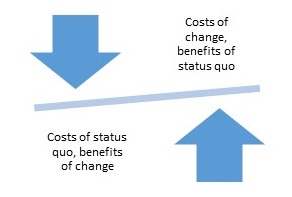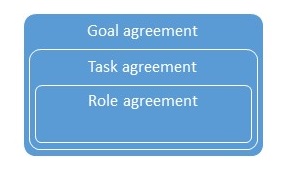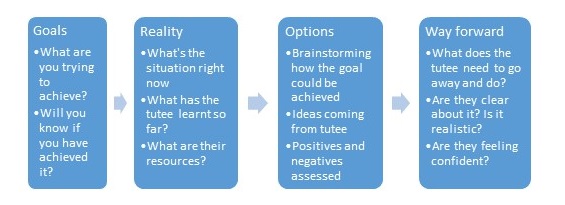It can be tempting for Academic Tutors to try and provide all of the answers for their tutees, or to tell them what you think they ought to do (e.g. “go and see Study Advice” or “these are the aspects of your work you need to focus on”). Of course there will be times when it is appropriate to offer advice and guidance, but effective Academic Tutoring is about creating an environment where your tutees can explore their issues, and encouraging them to come up with their own solutions. This can be done by using a variety of techniques, for example:
Aim: Supporting tutees who are ambivalent or resistant about change.
You can use this by noticing when a tutee:
- is feeling two ways about something
- is starting to argue, interrupt, ignoring, side-tracking, blame or be pessimistic
You can use this by:
- asking the tutee about the advantages and disadvantages of changing or not changing
- asking them what would happen if they didn’t change
- asking what would happen if they did?
- encouraging positive thinking
Aim: to make sure the tutorial process is clear and expectations are communicated.
You can use this when:
- you start a tutorial conversation
- when you feel your conversation is going off topic
- It doesn’t feel like a tutor meeting!
You can use this by:
- Setting expectations at the start – how long will this tutorial be? What is the purpose? What might happen next?
- Agreeing together what you’re going to cover and how you’re going to cover it (goal and tasks)
- Explaining the role that you each have in this – make sure the tutee is clear if they’re to listen respectfully or work collaboratively
Aim: Increase the tutees reflection and personal effectiveness
You can use this when:
- In dialogue with a tutee
- You need to make the discussion more productive by eliciting more reflection in the student.
You can use this by:
- Leaving silences to allow time for tutees to think and respond (feels awkward but can be really effective)
- Summarising the discussion so far
- Rephrasing what they’ve said so that they can hear it back and reflect on it
Aim: Helping a tutee to make their own decisions
You can use this when:
- A tutee isn’t sure what to do
- A tutee needs to think more deeply about something
You can use this by trying out some of the below:
- Asking ‘on a scale of 1 to 10…’
- ‘If all obstacles were removed…’
- ‘If you were someone else, how might you view this situation?’
- ‘If there was only X and Y as options, what would you choose? What would make that a better choice?’
- ‘What could go wrong here? How likely is it, and what damage would it cause? What could you do to mitigate that risk or repair the damage?’
- ‘Spend 2 minutes convincing me of X. Then Y. Which was harder to do?’
Aim: Structuring a discussion with a tutee
You can use this when:
- You want to make sure you achieve something in the tutorial
You can use this by:
- Using a structure – GROW – Goals, Reality, Options, Way forward

Aim: Finding out information
You can use this when:
- You want to explore more aspects of what’s going on
You can use this by being aware of different question types:
- Closed questions – with single or yes/no answers. Too many of these can feel like an interrogation, and doesn’t encourage the student to engage in discussion e.g. ‘Did you meet that deadline?’
- Open questions – without a yes/no answer. Encourages the student to think deeper or tell you more. E.g. ‘How has getting your work in on time been going’
- Leading questions – contain an assumption – avoid if you can! E.g. ‘Are you behind in your work?’
- Laden questions – contains an extra layer of meaning, often a value that you hold, but that might not be relevant to the student. E.g. ‘Being behind in your work can make you stressed, can’t it?’
Aim: Moving the conversation from the particular to the general
You can use this when:
- You want to help the student see connections between things, spot patterns, or transfer learning to other settings
You can use this by:
- Gradually asking broader questions, e.g. ‘Have you experienced these issues in other modules?’
‘Are there other areas of your life where you’ve had these issues?’
Aim: Moving the conversation from the general to the particular
You can use this when:
- You want to explore the exact basis of a topic of discussion
You can use this by:
- Gradually asking more specific questions, e.g.
‘Can you tell me what you mean by that?’
‘Could you give me an example?’
‘What exactly did you do there?’
‘What aspect in particular is most important?’
As a general rule of thumb, go down the ladder before you go up!
If you want to find out more about some coaching approaches you may like to look at the slides from this UKAT webinar:
Using Solution-focused Coaching with Students
This webinar aims to help attendees:
- understand solution- focused coaching and the solution- focused approach;
- consider the key characteristics of using a solution- focused approach in the personal tutoring role;
- explore how solution talk and problem talk questions can impact student success;
- examine and demonstrate the use of frameworks (such as GROW, OSKAR and BATHE) for coaching conversations in tutoring interactions with students
- contemplate the role of success coaching in US Higher Education and it’s potential relevance to the UK